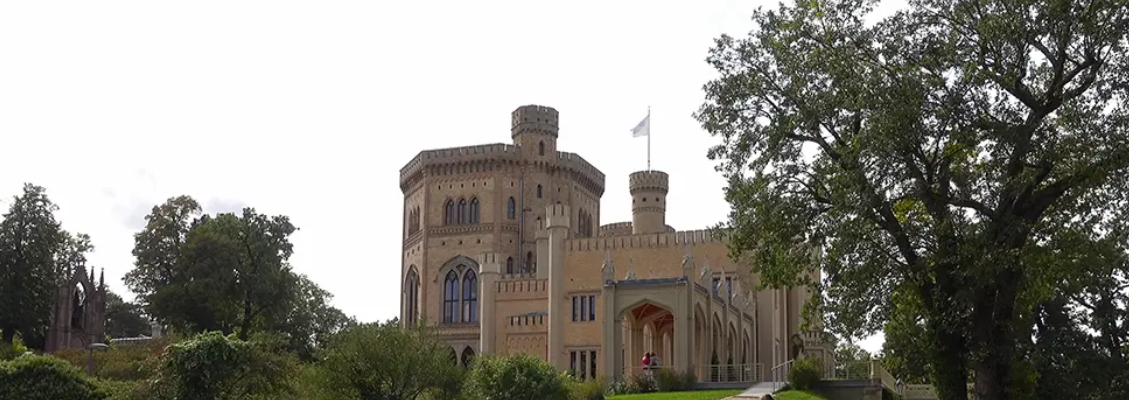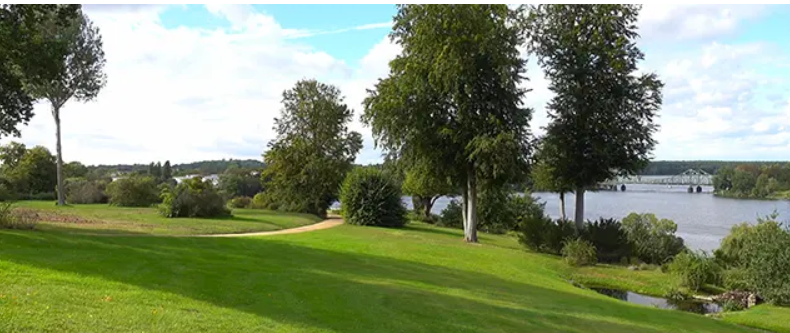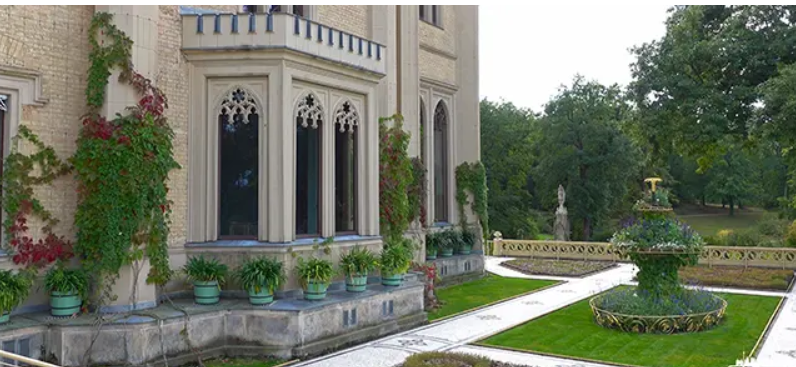A popular tourist destination inspired by England’s Windsor Castle
Address: Babelsberg Palace and Park, Park Babelsberg 10, 14482 Potsdam | Built: from 1833 | Architectural style: Tudor style
Babelsberg Palace and its park in Potsdam are a Prussian palace that commemorates the reign of Emperor Wilhelm I and brings a bygone era back to life. It served as a summer residence for the imperial family and their court, was built in the Tudor style, and also boasts a tranquil park with charming features. This listed building is one of the places where visitors can immerse themselves in the imperial era and experience Prussian history in an authentic way.
Directions and Location of the Potsdam Landmark
The World Heritage Site of Babelsberg Palace, with its extensive park, is picturesquely situated on the banks of the Havel River and offers impressive views of the river and the surrounding landscape. Prince Wilhelm of Prussia (later Emperor Wilhelm I) used the palace as a summer residence for a time. In later years, it was not only the seat of government but also an official representative building.
Directly adjacent to Babelsberg Palace and its extensive park, the road leads past Babelsberg Park, which surrounds the palace on two sides. Driving past the palace, you pass the steam engine house on the riverbank. A little further on is the Klein Glienicke Park Bridge, which provides access to the park and palace from the other bank of the Havel. The extensive park is bordered on the other side by the Avenue to Glienicke and runs past the University of Potsdam, District 2, and Babelsberg Park.
Opening Hours and Tours
Due to renovation work at Babelsberg Palace, visitors are currently unable to view the interior. However, the palace is open from May to October for numerous events.
The park is open to visitors and can be visited year-round from 8:00 a.m. until dusk.

Admission Prices for Babelsberg Palace and Park
Babelsberg Palace is currently closed to visitors, and accordingly, there is no admission charge for a tour. However, there are special events during which Babelsberg Palace can be entered. Admission prices depend on the specific event.
Those wishing to visit the park are free of charge. However, a park map is available at the park entrance. This costs €2, and the proceeds go towards the maintenance and preservation of the park.
Guided Tours of Babelsberg Palace and Park
A guided tour of the palace is not currently offered. However, it is possible to take a guided tour of the park to immerse yourself in the landscape architecture and learn more about the buildings, monuments, fountains, and water features.
FAQ – Frequently Asked Questions about Babelsberg Palace and Park
When were Babelsberg Palace and Park built?
Babelsberg Palace and its surrounding park were built in the 19th century. Construction of the palace began in 1833 under the direction of the architect Karl Friedrich Schinkel, commissioned by Prince Wilhelm, later Emperor Wilhelm I of Germany.
When does Babelsberg Park close?
Babelsberg Park opens at 8:00 a.m., and the park generally closes around dusk, usually between 5:00 p.m. and 8:00 p.m., depending on daylight conditions and the park’s specific regulations.
How large is Babelsberg Park?
Babelsberg Park covers an area of approximately 124 hectares. It is a sprawling landscape park that includes various garden styles and elements, including woodlands, meadows, water features, gardens, and architectural structures.
Who owns Babelsberg Palace?
Babelsberg Palace now belongs to the Prussian Palaces and Gardens Foundation Berlin-Brandenburg (SPSG). It is a UNESCO World Heritage Site and is managed by the foundation, which is responsible for the care and preservation of historic palaces, gardens, and parks in Berlin and Brandenburg.
Babelsberg Palace and Park – Special Features and Interesting Facts
Not only the imposing Babelsberg Palace is a special attraction, but also the parkland surrounding the palace. It is picturesquely situated on the banks of the Havel River and offers, among other things, a spectacular view of the Glienicke Bridge, which spans the Havel River. The palace gardens and their special features can also be explored.
The park surrounding Babelsberg Palace was created in 1833 at the behest of Emperor Wilhelm I and his wife Augusta. Prince Hermann von Pückler-Muskau and Peter Joseph Lenné, both renowned garden artists, were commissioned to design the park.
Babelsberg Palace was surrounded by tastefully designed garden terraces. Their exclusive, richly decorated design complements the view of the palace in a unique way. Adjacent to this is a pleasure garden with lush flowerbeds and ornamental shrubs. There are also enchanting water features to discover, inviting you to linger.
The park can be explored via numerous paths. A stroll continually offers new impressions and perspectives of Potsdam and the Havel landscape. Streams, waterfalls, and artificial lakes stylishly complement the park surrounding Babelsberg Palace.
Those who stroll through Babelsberg Park with open eyes can discover various monuments that commemorate the military successes achieved by Wilhelm as a Prussian prince, king, and emperor, such as the imposing Victory Column.
Not only Babelsberg Palace, but also Babelsberg Park is a UNESCO World Heritage Site. After the fall of the Berlin Wall, the northern area on the banks of the Havel River, which had suffered severe damage from the border fortifications, was restored.
Babelsberg Palace is currently being renovated with the aim of reopening it to visitors at a later date.


Historical Information and History of Babelsberg Palace and Park
Babelsberg Palace was built for Prince Wilhelm of Prussia in 1833. The building was constructed in the English Neo-Gothic style for the future Emperor Wilhelm I and his wife Augusta. The palace served as a summer residence for over 50 years, first for the royal couple and later for the imperial couple.
The palace was first built between 1833 and 1835 according to plans by the architect Karl Friedrich Schinkel. It was a small building, barely the size of a cottage. When Prince Wilhelm of Prussia was named heir to the throne in 1840, a more prestigious palace was naturally needed.
The new official title that Prince Wilhelm now held was also to be reflected in his palace. The architects Johann Heinrich Strack and Ludwig Persius expanded the palace between 1844 and 1849 at the heir to the throne’s request.
The interior of the summer residence was designed with the active involvement of Augusta and Wilhelm. Babelsberg Palace held a very high status in the political and social life of Prussia, from the 1860s to the 1880s. The climax was the proclamation of Wilhelm I as emperor in 1871.
The palace façade and the five terraces have been extensively renovated, and since 2016, the palace has regained its former, magnificent appearance. The terraces surrounding the palace appear like open-air rooms. After more than 100 years, the water features can once again be admired from April to October.

Sights and attractions in the immediate vicinity of Babelsberg Palace and Park
Anyone visiting Babelsberg Palace and Park will find plenty of sights and attractions there.
While strolling along the numerous paths in the park, a special monument can be discovered at its highest point. There stands the Victory Column, erected as a symbol of Prussian victories. It commemorates the victory the Prussians won against Austria in 1866.
The Generalsbank is also located nearby. The stone bench has a semi-oval shape and was built as a memorial to the generals of the so-called Wars of Imperial Unification. Portrait busts of them can be found on the back of the bench.
If you walk towards the banks of the Havel River, you can’t miss the historic steam engine house in Babelsberg Park. It was built to irrigate the park. Although the building cannot be viewed from the inside, its unique architecture is still a great eye-catcher.
Also worth seeing is the Gerichtslaube (courtyard arcade) in Babelsberg Park. The building can be seen from afar and its perfect architecture makes it a great photo opportunity. If you gaze at the top of the Gerichtslaube (courtyard arcade), you’ll enjoy a magnificent view of a large part of Potsdam.
Close to Babelsberg Palace and Park is Babelsberg Film Park. There, visitors can take a look behind the scenes and learn how films are made. There are attractions to marvel at that explore the theme of film in many different ways.
Also worth seeing is the Glienicke Bridge, one of Potsdam’s most famous sights. During the Cold War, the Glienicke Bridge was an important location that was not only perfectly secured but also easily accessible to all powers involved. Agents and spies were exchanged there between the Soviet Union and the USA. If you walk across the Glienicke Bridge with your eyes open, you’ll discover a metal band that commemorates the former division between East and West Germany.
A small island in the Havel River is also not far from Babelsberg Palace and Park. It’s Peacock Island, known for its beautiful parkland. There, visitors can encounter magnificent peacocks and watch the males spread their tail feathers to impress the females and scare off predators.
Cafés and Restaurants Near Babelsberg Palace and Park
Long walks and sightseeing tours of the palace and through Babelsberg Park are perfectly rounded off with a delicious coffee and cake or a small meal to take in the fascinating sights. For this very reason, there is a lovely selection of restaurants and cafés near the palace and park, serving guests sweet temptations and culinary delights.
Coffee Garden at Babelsberg Palace
The coffee garden is located directly next to Babelsberg Palace. With a view of the imposing building and the park, guests can enjoy coffee specialties and cakes. The menu offers a lovingly curated selection of dishes, ensuring there is something for everyone.
Address: Coffee Garden at Babelsberg Palace, Park Babelsberg 10